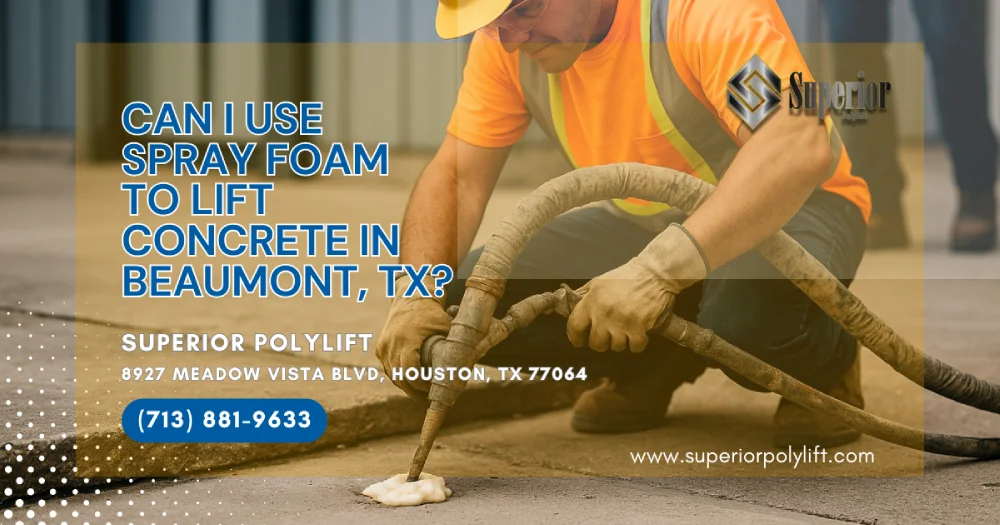
Yes, you can use polyurethane foam for lifting and leveling concrete in Beaumont, TX, a method known as polyjacking or LEVELift, which is a more efficient and durable alternative to traditional mudjacking. When heavy slabs settle in the Gulf Coast’s moisture-rich soils, you might assume costly tear-out and replacement is your only option. Polyurethane foam lifting offers a faster, cleaner, and cost-effective fix that brings the concrete surface back to its original height—saving budgets on large–scale commercial floors and port aprons.
In just hours, precisely injected foam expands beneath the slab, re-establishing grade and load capacity while minimizing downtime. Below, you’ll learn exactly how the process works, why it excels in Beaumont’s climate, and what to expect from start to finish.
The Gulf Coast’s expansive clays, fluctuating moisture, petrochemical traffic, and heavy equipment loads make concrete settlement a recurring challenge. Polyurethane foam concrete lifting, often branded as polyjacking or LEVELift, counteracts this by injecting lightweight, high-strength foam beneath the slab, filling voids and raising it back to grade.
Polyjacking involves drilling 5/8-inch ports through the slab, then pumping a two-part polyurethane resin beneath it. The components mix, expand up to 25 times their liquid volume, and cure within minutes, gently lifting the slab while compacting underlying soils.
| Method | Typical Hole Size | Added Weight (lb/ft³) | Traffic Reopen | Average Cost Range* | Ideal Uses |
| Polyjacking | 5/8" | 2–4 | 15–60 min | $4–$7/ft² | Industrial, municipal |
| Mudjacking | 1½"–2" | 100–140 | 24–48 hr | $3–$6/ft² | Limited situations |
| Full Replacement | — | — | 7–28 days | $8–$14/ft² | Severely broken slabs |
*Regional averages for projects in Beaumont, TX and surrounding parishes; actual pricing varies by thickness, access, and volume.
Lifting foam reaches 90 % strength in 15 minutes, so forklifts, semi-trailers, and refinery service vehicles can resume almost immediately. Businesses avoid long shutdowns and lane closures common with replacement.
Closed-cell foam resists water infiltration, salt, crude-oil drips, and petrochemical exposure. It maintains structural integrity even when Beaumont sees 60+ inches of annual rainfall or storm-surge flooding.
Because foam weighs less than 4 lb/ft³, it stabilizes without adding significant load to already soft sub-grades. Mudjacking grout can re-sink slabs by burdening soils with 20–30 tons of slurry.
The 5/8-inch ports are much more inconspicuous once we patch the holes, compared to traditional 2-inch mudjacking “buttons.” Facility aesthetics and safety striping stay intact.
From ports to petrochemical plants, Beaumont’s infrastructure depends on level slabs for efficiency and safety.
Uneven expansion-joint edges hinder forklift movement and damage palletized goods. Foam lifting restores flatness overnight, letting crews return to full production the following morning.
Service driveways that accept tankers or heavy rolling stock often suffer sunken panels. Polyjacking’s rapid cure reduces schedule disruptions and meets DOT load ratings.
Taxiways settle under jet thrust and fuel leakage. Polyurethane concrete lifting produces fast, reliable lifts that satisfy FAA strength requirements.
Industrial porta-cabins and portable buildings often sit above shallow crawl spaces. Foam injection fills hidden voids, supporting skids and utility chases while avoiding full crawl space encapsulation costs.
Situated near the Neches River delta, Beaumont faces geotechnical factors that accelerate slab movement.
Expansive clay layers shrink during droughts and swell after rains, undermining slab support. Polyurethane foam penetrates fissures, binds loose soils, and mitigates volumetric cycles.
Storm surges and heavy rain wash out fines under concrete. Closed-cell foam forms a moisture barrier, locking soils in place and resisting erosion.
Refineries and terminals move massive loads daily. The foam’s compressive strength—often above 100 psi—handles frequent dynamic forces without crushing.
Knowing how a crew operates sets expectations for scheduling and coordination.
Technicians laser-scan the slab, document settlement magnitudes, and mark injection points to achieve uniform lift. Recent concrete raising analytics guide the plan.
5/8-inch holes are core-drilled on a grid pattern. Dust is collected to keep the environment clean and safe for ongoing operations.
Operators inject foam incrementally, watching elevation gauges in real time. The expanding foam is injected until the concrete slab returns to grade—avoiding over-lifting.
Ports are patched with high-strength mortar. After a brief cure, the surface is swept, inspected, and reopened—often in under four hours from arrival. Most clients wait to use the area only long enough for the patch to set.
Bullet-point recap:
Polyjacking’s value lies in more than just unit price.
Key pricing variables include:
Each free quote will outline the injection process, foam volume, and exactly what it’s going to cost.
Below are concise answers to common queries specific to large-scale leveling services in Beaumont, TX.
When correctly installed, foam maintains density and strength for decades. Field data show lifts exceeding 20 years with negligible movement, especially when proper drainage and joint sealing are maintained.
The cured foam is chemically inert, non-toxic, and meets EPA guidelines. Its closed-cell structure prevents leaching into groundwater, making it a greener option than cement-based slurries.
Yes. Crews often stage during low-traffic windows, keeping one lane or work zone open. The small equipment footprint and rapid cure allow continuous production for most facilities.
Not all foam-lifting providers deliver equal results. Superior PolyLift™ has the experience in the concrete industry and certified concrete levelers to ensure every job is done right the first time.
Superior PolyLift™ offers a wide range of commercial concrete lifting and stabilization services—from driveway aprons to interior leveling inside hangars. If you would like a quote, please feel free to either contact us via phone or fill out the contact form on this page to set up your free quote. Our foundation support specialists will explain how our concrete lifting foam surpasses methods used by mudjackers and outline the compressive and shear strength specifications. Give us a call today and see how quickly we can bring your concrete to level.
Polyurethane spray foam lifting provides Beaumont’s industrial and municipal sectors a swift, durable remedy for sunken or uneven concrete. The process uses lightweight, waterproof foam to fill voids, raise slabs, and stabilize sub-grades, with traffic often resuming the same day. Benefits include smaller drill holes, minimal added weight, and proven longevity in Gulf Coast conditions. Compared to traditional replacement, polyjacking cuts costs, curtails shutdowns, and extends service life. If settled concrete threatens safety or efficiency, schedule a professional evaluation to see how Superior PolyLift™ can restore grade and reliability—quickly, cleanly, and cost-effectively.

Explore how our expertise can benefit your project. Reach out to our team for a consultation and discover the best solutions for your needs.
Copyright © All rights reserved. 2024 • Terms of Use and Privacy Policy • Internet Marketing by Authority Solutions®